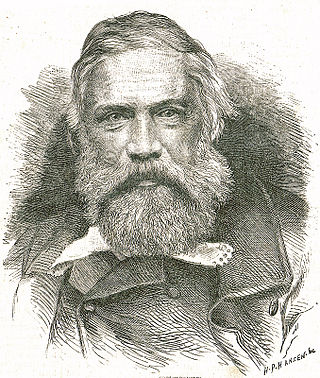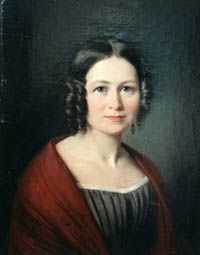
Carl Christian Constantin Hansen (Constantin Hansen) (3 November 1804 – 29 March 1880) was one of the painters associated with the Golden Age of Danish Painting. He was deeply interested in literature and mythology, and inspired by art historian Niels Laurits Høyen, he tried to recreate a national historical painting based on Norse mythology. He painted also many altarpieces and portraits, including the monumental oil painting The Danish Constituent Assembly (Den grundlovgivende Rigsforsamling) between 1861 and 1865.

Niels Wilhelm Gade was a Danish composer, conductor, violinist, organist and teacher. Together with Johan Peter Emilius Hartmann, he was the leading Danish musician of his day, in the period known as the Danish Golden Age.

Niels Viggo Bentzon was a Danish composer and pianist.

The Royal Danish Academy of Fine Arts has provided education in the arts for more than 250 years, playing its part in the development of the art of Denmark.
The Danish Golden Age covers a period of exceptional creative production in Denmark, especially during the first half of the 19th century. Although Copenhagen had suffered from fires, bombardment and national bankruptcy, the arts took on a new period of creativity catalysed by Romanticism from Germany. The period is probably most commonly associated with the Golden Age of Danish Painting from 1800 to around 1850 which encompasses the work of Christoffer Wilhelm Eckersberg and his students, including Wilhelm Bendz, Christen Købke, Martinus Rørbye, Constantin Hansen and Wilhelm Marstrand, as well as the sculpture of Bertel Thorvaldsen.

Johan Peter Emilius Hartmann was, together with his son-in-law Niels W. Gade, the leading Danish composer of the 19th century, a period known as the Danish Golden Age. According to Alfred Einstein, he was "the real founder of the Romantic movement in Denmark and even in all Scandinavia". J.P.E. Hartmann was the third generation of composers in the Danish musical Hartmann family.
Franz Adolf Syberg was a Danish composer.
Niels Finn Høffding was a Danish composer. Høffding studied composition under Knud Jeppesen and Thomas Laub, and then under Joseph Marx in Vienna from 1921-22. His works first became well known in Denmark in the 1920s, particularly the piece Karlsvognen. He began to study folk music about 1930, and founded the Copenhagen School of Folk Music in 1931. From 1931 he also taught at the Royal Danish Academy of Music, where he served as director after 1954. In 1956 and 1958 he was awarded the Nielsen Prize. His pupils include Pelle Gudmundsen-Holmgreen, Vagn Holmboe, Bent Lorentzen, and Leif Thybo. See: List of music students by teacher: G to J#Finn Høffding.
Emilius Bangert was a Danish composer, organist, and professor. He played the organ at Roskilde Cathedral and also composed orchestral and chamber music.
Jørgen Ditleff Bondesen was a Danish composer and music theorist.

Amalia Emma Sophie Hartmann née Zinn was a Danish composer who composed under the pseudonym Frederik H. Palmer. She was married to the composer Johan Peter Emilius Hartmann (1805–1900). They lived on the second floor in the Zinn House at Kvæsthusgade 3 in Copenhagen.

Johann Ernst Hartmann was a Danish classical composer and violinist. He is remembered in particular for his two operas on texts by Johannes Ewald in which he helped creating a national musical style. The first of these, Balders død, builds on the old Nordic mythology and uses dark colours when depicting the old Gods and Valkyries. The second, Fiskerne, describes contemporary fishermen’s lives, and uses melodies inspired by the Scandinavian folk style.

Frederik Rung was a Danish conductor and composer.

August Winding was a Danish pianist, teacher and composer.

Syddansk Musikkonservatorium - Danish National Academy of Music, as it is now known, is located in Esbjerg, Denmark, opposite St Nikolaj Church. Founded in 1946 as a local private initiative, it was first known as Vestjysk Musikkonservatorium. In 1972, it was taken over by the national authorities.

Musikforeningen in Copenhagen was Denmark's most important concert venue in the 19th century. It operated from 1838 to 1931 but it was especially under the leadership of Niels Gade (1850–90) that it became a meeting place for the city's music life with its own symphony orchestra and choir. Carl Nielsen was director from 1915–27. Other leaders included Franz Gläser, Emil Hartmann and Franz Neruda.
Dan Fog was a Danish music antiquarian and publisher who is remembered principally for his Danish music catalogues and biographies of Scandinavian composers.

Niels Johannes Fjord, often referred to as N. J. Fjord, was a Danish Professor at the Royal Veterinary and Agricultural University. He was a pioneer in dairy and milk research in the mid-1800s. He was a driving force and the first leader of the Landøkonomisk Forsøgslaboratorium on Rolighedsvej in 1883.
The Hans Egede Medal is awarded by the Royal Danish Geographical Society for outstanding services to geography, "principally for geographical studies and research in the Polar lands." It was instituted in 1916 and named after Hans Egede, a Danish missionary who established a mission in Greenland.

The Danish Music Museum is located in Rosenørns Alle 22 in Copenhagen, Denmark. The building is shared with the Royal Danish Academy of Music.













